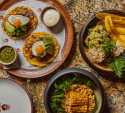Best ever roast duck
Indulge in Tom Kerridge’s ultimate roast duck at Christmas, with seasonal clementines and oranges. Serve with duck-fat roasties, watercress and gravy
-
Prep:40 mins
Cook:2 hrs
plus optional 24 hrs chilling - Serves 4
- More effort
Nutrition per serving
-
kcal 673
-
fat 57g
-
saturates 17g
-
carbs 10g
-
sugars 0g
-
fibre 0.1g
-
protein 30g
-
salt 0.7g
Ingredients
- 1 duck, legs separate from the crown and crown trimmed (you can ask a butcher to do this or buy two legs and a crown separately)
- 2 tbsp honey
- ½ clementine, zested and juiced, or ½ orange, zested, plus 2 tbsp orange juice
- duck-fat roasties, watercress and gravy, to serve (see below)
Tip
Duck-fat roasties The fat from the duck makes the best roast potatoes. To serve four, cut 800g Maris Piper potatoes into chunks, boil for 5 mins, then drain, ruffle and roast with the duck fat at 220C/200C fan/gas 7 for about 1 hr, turning them twice.Duck gravy Heat 1 tbsp sunflower oil in a shallow pan over a medium heat and brown parts of the duck carcass (if you asked a butcher to prepare the duck, ask for the offcuts) along with 1 chopped onion, 1 chopped carrot and a small piece of star anise. Scatter over 1 tbsp flour, then pour over 50ml port and bubble for 2-3 mins. Add 300ml chicken stock and reduce for 10-12 mins to thicken. Pass through a sieve.
Duck au vin Instead of slow-roasting the duck legs, they can be braised in red wine. Brown in a little oil with 1 chopped onion, 1 carrot, a sprig of thyme and 1 bay leaf then add 500ml red wine and 300ml chicken stock and simmer gently for 1 hr 30 mins, or until the meat is tender. Remove the legs and veg, then boil the juices down to make a sauce.
Glazing options I’ve used a classic glaze of orange and honey, but you could try a mix of soy sauce, honey and five spice powder, or maple syrup and balsamic vinegar.
The secret to crispy skin is to lightly salt the duck for 24 hrs before roasting. This makes the skin extra crisp and gives the meat a deeper flavour. You can also enhance the salt with spices, fresh herbs or grated citrus.
Method
If you have time, season the legs, cover and chill for up to 24 hrs to produce extra-crispy skin. Heat the oven to 150C/130C fan/gas 2. Put an ovenproof wire rack on top of a baking tray and sit the duck legs to one side of the rack, skin side up, and roast for 1 hr 45 mins until the skin is starting to crisp and the meat underneath looks pull-apart tender.
While the legs are roasting, lightly score the skin of the duck crown all over and season with salt (again, this can be done up to 24 hrs before). Mix all but 1 tsp of the honey with the citrus zest and juice in a bowl.
When the legs have had their time, remove the tray from the oven carefully and pour all the fat into a bowl to use for making roast potatoes, if you like. Turn the oven up to 220C/200C fan/gas 7, then sit the crown, skin side up, opposite the legs and brush with a bit of the fat. Roast everything for 20 mins, then brush the citrussy honey mix all over the crown and cook for another 10 mins. If the legs are now deep golden and crisp-skinned, lift them onto a board, or cook them for a little more time until you achieve this.
Brush the duck crown with the remaining honey, return to the oven for 4-5 mins, then brush over a bit more. After about 10 mins in total, the duck crown meat should be pink and read 60C on a cooking probe – if you prefer it more cooked, but still succulent, give it another 4-5 mins or take it to 65C. Remove the crown to a board with the legs and leave to rest for at least 10 mins. Carve the crown at the table and serve each person half a leg along with duck-fat roasties, a big bunch of watercress and some gravy (see recipes, below).




















